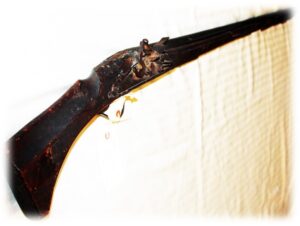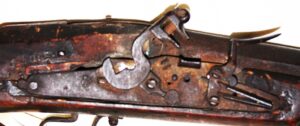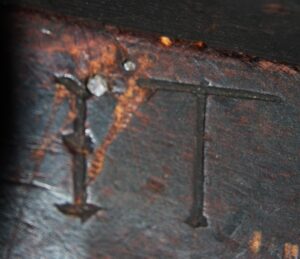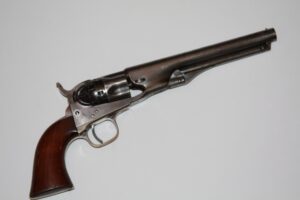Jun 2, 2023
In the MHS weapons collection there exists a musket cataloged as the “Mayflower Musket.” There is little to no documentation to substantiate this title, so the Society has enlisted several knowledgeable people over the years to supply their opinions. None has been able to definitively identify the piece, its age or its importance.

MHS networks with other historical museums and historical societies to strengthen our knowledge and strategies. Through this effort we became acquainted with Adams Shipman of the Natick Historical Society. He has a healthy interest in history and antique firearms and had read an article on another Mayflower gun. He remembered our “Mayflower Musket” and contacted us to see if we would be interested in having some real weapons experts take a look and give us a true assessment. Of course, we were excited about the possibly of acquiring an accurate assessment.
Adams contacted his friends Joe Puleo and Stuart C. Mowbray, weapons experts of Rhode Island. Stuart writes articles for the Man at Arms for the Gun and Sword Collector, which is the NRA Journal for the American Arms Collector, and is always searching for new and exciting firearms stories. Puleo and Stuart have co-authored several publications on military firearms and Stuart is an established author of firearms guides.
Once at the society, they admitted that they did not have much faith that the story of the “Mayflower Musket” would pan out. They told us of many other investigative excursions that had not ended well. I think they were trying to lessen the blow for us.
Though the claim of “Mayflower” origin may never be substantiated, determining its age and significance can be accomplished. The experts informed us that the gun was an early 17th century military longarm, which was an exciting moment for us as it made the Mayflower legend plausible!
They went on to say that this particular stock shape was manufactured around 1620 (plus or minus a few years) and they believe that the buttstock length was shortened sometime during its useful life. With the manufacture date of about 1620 this would undoubtedly mean the original gun was made in England since there were no gunsmiths in Massachusetts at that time. The Mayflower landed in Provincetown, Massachusetts on November 21, 1620 and then again in Plymouth, Massachusetts on December 21, 1620. Clearly, with these dates we can reasonably conclude that the gunstock was produced in England.

In examining the gun, it was apparent that the original lock mechanism had been replaced since there were modifications to the original mortise with shims to accommodate the new lock. The replacement lock is an “English lock.” Typically, the English snaphance lock was replaced, by the colonist, with an “English lock” starting around 1640. This means that this musket is not only a notable English artifact but is also a significant early American artifact since the lock itself was probably crafted in New England.

Looking closer, some crudely carved initials I.T. are visible on the side of the buttstock. During the 15th and 16th centuries the letter “J” was often written as an “I”. In 1918 the gun was donated by Stephen Turner. We can assume the gun was passed down through the Turner family of Medfield and John Turner was the original owner.
As far as we know, John Turner of Medfield was born in England in 1617, immigrated to America in 1635, settled in Roxbury, Massachusetts, and came to Medfield in 1651 with the original thirteen settlers. He received a house lot on the west side of South Street not far from Curve Street. In 1667 he was permitted to build a cellar hole across the street from his house and in 1668 was allowed to set his house on this cellar. The new location was at the corner of South and Phillip Streets.
The King Philip attack on Medfield was on February 21, 1676 and half the homes in Medfield were burned to the ground. Countless people were slain or wounded. John Turner had nine children and a wife at the time. His daughter Elizabeth was married to Samuel Smith and they resided on the same street not far from her childhood home. Elizabeth took flight to the fort with her baby boy, Samuel, on that dreadful day. She did not get far before she was struck in the head and killed by the Indians. Baby Samuel survived by the shelter of his mother.
We can only speculate if this musket was used to save Medfield townspeople that day, but it is quite likely if it was in the possession of the Turner family at that time.
The passenger list from the Mayflower does list a John Turner, but he was born in 1590 and died in 1620 along with his two sons, so he was not Medfield’s John Turner.
It appears that our man came to America in 1635 on the Speedwell. It is quite possible this was the very ship that was planned to be the sister ship to the Mayflower. The Speedwell, however, took on water and had to return to England. The Speedwell was sold, repaired and made many successful voyages thereafter. The 1635 passage was probably one of those trips.
The conclusion of these two notable experts was, and I quote, “This is certainly a significant historical longarm. Having been donated by the family during the 19th century, it by far predates the era when a musket like this would have been imported as an antique collectible, and its overall condition speaks strongly of colonial use. We could be looking at a very important early firearm, indeed!”
Joe Puleo and Stuart C. Mowbray did not just assess the “Mayflower Musket” but volunteered to evaluate our entire collection of weapons; this was no small endeavor since our collection is expansive. There were a couple of other shining stars such as the U.S.S. Constitution Sword and the Richard C. Derby revolver, which had been recovered from his body on the battlefield at Antietam.

Both the “Mayflower Musket” and the “Richard C. Derby Colt Revolver” were showcased in the December 2014 issue of Man at Arms for the Gun and Sword Collector magazine. The Derby revolver was placed on the prestigious “Roll of Honor” page which is reserved only for firearms of importance and excellence. The magazine is available for viewing at the Medfield Historical Society or click here to purchase a copy.